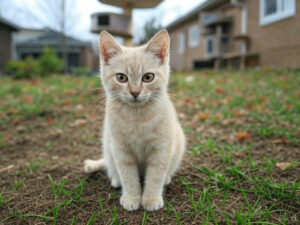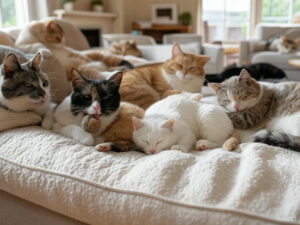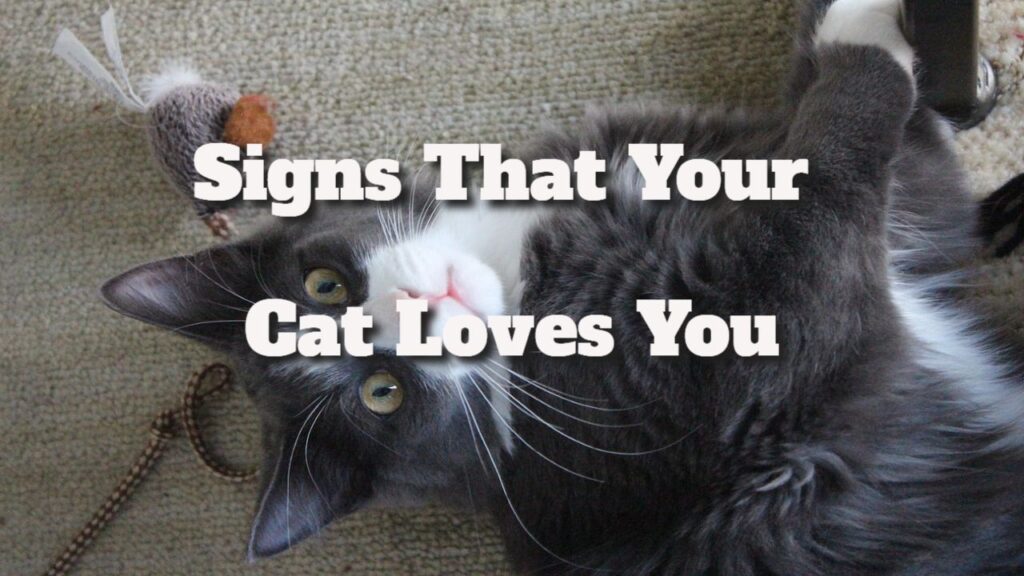Your cart is currently empty!
Category: Cat Behavior
-

Is Your Cat a Victim of Bullying? Signs to Identify It
Discover the Signs of Cat Bullying: Understanding Your Cat’s Emotional Struggles
Is your beloved cat experiencing distress from bullying behavior? Just like humans, cats rely on positive social interactions to maintain their emotional well-being. Unfortunately, not all engagements are friendly. Some cats may adopt bullying behaviors to assert dominance over others, whether they are part of the same household or in the neighborhood. Understanding the intricacies of these bullying dynamics is vital for helping your cherished feline regain their confidence and feel secure in their environment.
Unlike playful roughhousing, which often signifies affection, bullying in cats typically manifests as aggressive actions meant to intimidate. This behavior transcends a mere swipe or hiss; it develops into a consistent pattern of demeaning conduct. For example, one cat might habitually guard food bowls or obstruct pathways, creating an atmosphere of fear for other cats. Early recognition of these troubling behaviors is crucial to safeguarding your pet’s mental health and ensuring a harmonious household.
Swiftly addressing bullying situations is essential to prevent them from escalating into more severe issues. A bullied cat may start avoiding specific areas, become less sociable, or even refuse to use the litter box due to fear. These signs are indicators of your cat’s distress, and identifying them early can help protect their physical health and emotional tranquility. The sooner you act, the more successful your interventions will be in restoring peace and stability to your cat’s living environment.

Recognizing the Key Indicators That Your Cat is Experiencing Bullying
Cats lack the verbal skills to articulate their feelings, yet their behaviors and physical aspects can provide significant insights into their emotional state. If your feline companion is at the receiving end of bullying, various distress signals may indicate their discomfort. Pay attention to these signs for a better understanding of your cat’s well-being.
Look for physical indicators such as scratches, bite marks, or patches of missing fur, which may serve as silent evidence of confrontations with a more aggressive cat. However, not all symptoms are visible externally. Behavioral changes are equally telling; a previously sociable cat may become withdrawn, frequently seek hiding spots, or exhibit sudden aggression that was once absent. These shifts in behavior can reveal a lot about your cat’s emotional challenges.
Changes in eating and litter box habits can also signal underlying issues. Is your cat eating less than usual or skipping litter box visits? These behaviors may stem from fear or stress, particularly if a dominant cat is guarding these vital resources. Even within the comfort of home, if your furry friend seems skittish or hesitant, it could indicate a perceived lack of safety, as they may feel constantly on high alert for bullying. Observing these changes is vital for early detection and intervention.
Understanding Territorial Invasions: When Aggressive Cats Encroach on Your Cat’s Space
Your home should be a sanctuary for your cat, offering safety and comfort. However, if a bully cat believes they can invade your space, that sense of security can be compromised. Some cats are bold enough to trespass onto your property, especially if there are easy access points. This situation can transform what should be a haven into a source of stress for your resident feline.
If you notice your cat appearing anxious at home while a neighbor’s cat lounges around, it’s time to investigate further. Bullies often exploit open doors, unsecured windows, or cat flaps, seizing any opportunity to assert dominance over your cat. As a result, your kitty may start avoiding certain areas of the house or become startled by sudden noises. These subtle behavioral changes can be significant indicators of their stress levels and emotional well-being.
Recognizing the impact of these territorial invasions is crucial for maintaining your pet’s emotional comfort. Once you identify where breaches in security are occurring, you can take proactive steps to ensure your home remains a safe haven for your beloved feline. Creating a secure environment is fundamental to restoring your cat’s peace of mind and overall happiness.

Enhancing Home Security: Crafting a Safe Haven for Your Cat
Transforming your home into a fortress for your feline companion involves sealing off entry points that bully cats often exploit. One effective strategy is to install a cat flap with selective entry features. This innovative solution allows only your cat to come and go freely, effectively blocking unwanted visitors from entering your home and asserting control over your kitty’s space.
Windows can also serve as potential entry points for intruders. Installing screens on windows that are frequently left open can help prevent unwanted incursions while still allowing fresh air to circulate within your home. This way, you can maintain a comfortable and breathable environment while protecting your cat’s territory from aggressive invaders.
Furthermore, consider the arrangement of shared resources like food bowls and litter boxes. Dominant cats may attempt to block access to these essential areas, so it’s vital to ensure they are positioned in secure locations. By distributing resources throughout your home, you can complicate a bully cat’s ability to monopolize them, effectively creating a protective barrier that ensures your cat’s territory remains theirs while maintaining peace.
Creating Safe Outdoor Spaces for Your Cat’s Exploration and Enjoyment
Outdoor adventures can be delightful for your cat, but they may quickly become stressful when bullies are present. Designing safe areas in your yard can significantly ease your cat’s anxiety about exploring the great outdoors. It’s essential to create an environment where your feline can feel secure while enjoying their time outside.
Consider adding cat platforms along fences or trees. These elevated spots provide your cat with an excellent vantage point and an escape route if a threatening cat appears. High ground can serve as a confidence booster, allowing a timid kitty to feel safer while observing their surroundings from above.
If possible, providing access to a shed or garage can create small shelters where your cat feels secure. Even a simple outdoor cat house can offer refuge from assertive cats trying to invade their territory. These structures help ensure your cat feels protected and relaxed while spending time outdoors.
Additionally, consider incorporating landscaping features such as potted plants or small bushes that serve as cozy hideaways. These natural barriers can create peace and concealment from unfriendly neighbors, allowing your cat to enjoy their outdoor time without fear. By creating these little sanctuaries, you can ensure your cat’s outdoor adventures are both enjoyable and enriching.

Fostering Peace in Multi-Cat Households: Implementing Time-Sharing Techniques
Living with multiple cats doesn’t have to feel like a perpetual battleground. “Time sharing” is a fascinating approach where cats instinctively stagger their outdoor activities to avoid conflicts. This natural strategy can serve as an effective peacekeeping method that fosters a more harmonious atmosphere among your feline companions.
By understanding how this instinct operates, you can encourage your cat to utilize specific areas during quieter times, reducing the likelihood of encountering bully cats. For instance, feeding your cat during off-peak hours in the neighborhood can minimize potential confrontations with aggressive felines.
Observe the local feline activity patterns and adjust your cat’s schedule accordingly, allowing them to enjoy their preferred areas when the neighborhood is less populated. With some routine adjustments, you can guide your cat to utilize the garden or yard during times when aggressive cats are likely resting, ensuring their comfort and safety.
Establishing this structured sharing of time enables each cat in the area to enjoy their surroundings without undue stress. This approach not only encourages a sense of harmony within your home but also alleviates the need for cats to feel they must fight for every inch of territory, making shared spaces more enjoyable for everyone involved.
Mitigating Outdoor Fear and Anxiety: Ensuring Safe Toilet Habits for Your Cat
Fear can greatly hinder your cat’s willingness to venture outdoors, even for essential activities like using the bathroom. When a bully cat is nearby, the yard can suddenly turn from a familiar space into a daunting environment, causing your feline to hold back or completely avoid their usual outdoor spots.
Encourage gradual re-familiarization with these safe areas by accompanying your cat outside during quieter times. This gentle approach helps them rediscover their confidence without the looming threat of a dominating cat shadowing their every move.
Consider establishing alternative toileting areas positioned away from high-traffic zones that are less likely to be frequented by troublemaking cats. If outdoor stress levels remain too high for comfort, temporary indoor solutions may also ease the transition and ensure your cat’s needs are met without anxiety.
Diminishing intimidation factors is essential, often requiring you to observe and narrate the neighborhood drama like a true detective. By identifying the bully’s patterns and alerting your cat, you can help them gradually reclaim their territory without unnecessary confrontations, allowing them to feel safe in their own space.
Helping your feline friend regain their footing and old routines can transform your garden from a battleground into an enchanting paradise, allowing them to scratch, climb, and explore freely once again, enriching their lives.
The Article : Is My Cat The Victim Of Bullying Appeared First On Unity Pets.
The Article Is Your Cat a Victim of Bullying? Here’s How to Tell Was Found On https://limitsofstrategy.com
-

Signs That Your Cat Loves You
Signs That Your Cat Loves You
Our feline companions may not always communicate their emotions, so how can you tell if your cat loves you? Pets have ways of expressing their emotions.
Chances are, your cat is your secret lover! Look for these apparent signs of feline devotion.
Grooming
Many studies suggest that your feline companion sees you as a family member, although an over-sized cat (who isn’t particularly good at hunting). If she licks or grooms you, she considers you a valuable family member.
Biting is a playful manner for kittens to express affection, and your cat may do similarly towards you. However, if those sharp little teeth begin to hurt, do not react adversely because this will confuse her. Instead, distract her with a toy or activity.
Eye contact
If you’re wondering how to tell if your cat likes you, search for signs that she’s completely comfortable with you. Cats perceive eye contact with a stranger, whether feline or human, as threatening. If she is pleased to look you in the eyes, especially if she blinks gently, it indicates that she has warmly accepted you as one of her own.
Headbutts
Cats mark their territory with smell glands located on their cheeks and heads. So, by headbutting you or rubbing her chin against you, your feline companion affectionately recognises you as hers.
Generous ‘gifts’
If your cat brings you prey she has captured, she may act as a teacher by teaching her kittens to hunt. Because she has never seen you catch your food, she may think you are a family member who needs to be educated!
Tall tails.
A cat’s tail can convey her emotions and help you understand her body language. When your cat approaches with her tail raised high and the tip twitching from side to side, interpret this as international cat language for ‘I’m lovely, and I like you’.
Meowing
Adult cats rarely meow at one another. Instead, they communicate with others primarily through vocalisations. Cats, like people, are unlikely to speak to someone they despise. If your cat meows frequently (even when she is well-fed and warm), she may communicate with you out of affection.
Kneading
There are several theories as to why cats knead your knee, but scientists believe it is a technique kittens acquire to stimulate their mother’s milk production. By repeating this behaviour on you, your cat shows that she accepts you as a family member. If your pet adores kneading, try putting a big blanket between you and her busy paws.
They’re sleeping on you.
Your cat’s readiness to nap on your lap strongly indicates her feelings for you. As a natural predator, your cat dislikes feeling defenceless and is especially wary of feeling this way while sleeping. Sleeping on you displays her most vulnerable side while displaying her trust in you.
Presenting her behind.
Cats know one another based on scent, therefore sniffing one other’s behinds is the equivalent of a personal handshake. While extending her tail to your face may appear to be a backhanded compliment, it communicates that you are one of her most trusted confidants.
Why do cats like catnip?
As a cat owner, you understand the importance of keeping your cat entertained and providing ample playtime changes to improve their life. A variety of refreshments and playthings are also provided. Grooming your cat regularly and giving them attention may allow you to treat him with catnip occasionally.
What is catnip?
Catnip is a herb that originated in Asia. Due to its mint family origin, it has a unique, almost minty fragrance. It is widely planted and thrives in gardens and window boxes.
This plant is named for the effect it has on cats. The Latin name for catnip is Nepeta cataria. Catnip contains nepetalactone, a chemical that repels insects. It also attracts cats since its odour resembles cat pheromones.
Dried catnip is commonly available at pet shops around the United Kingdom. Catnip, like all dried herbs, becomes more robust and more potent as it dries, so if your cat is sensitive to catnip, it may substantially affect them.
How does catnip affect cats?
Your cat’s sense of smell is highly acute; thus, the scent of catnip is typically enticing to them. When the catnip plant is mashed or crushed, additional fragrance is released, encouraging a cat’s active behaviour. The fragrance is similar to that of a pregnant cat, thus cats can go mad when they smell it.
Catnip, on the other hand, can sometimes have a minor or no effect on cats.
Is catnip terrible for cats?
Catnip is typically considered safe for cats. It grows spontaneously, is widely available, and has short-term effects. Cat owners may easily limit the amount of catnip their cat has access to, and there is no way for a cat to overdose on it.
Cats do not usually desire to eat catnip. They want to smell it and rub it all over themselves. If they eat any suddenly, it may cause an upset stomach. It is a good idea to keep an eye on your cat in this condition and contact your veterinarian if you have any concerns.
As with other stimulants, you can have too much of a good thing. Catnip can cause cats to become overstimulated and aggressive. They may bite you, scratch you, zoom around, or grow disturbed. In this situation, remove the catnip and let your cat relax.
If you wish to offer your cat catnip, do so gently and in modest amounts. Please don’t give them too much at once; approach it as a nice treat rather than something to use daily.
Why do cats prefer catnip?
Different cats enjoy catnip for various reasons. There is evidence that particular cats are genetically predisposed to prefer catnip. Depending on their genetic makeup, some cats are unconcerned about catnip and may sniff it before walking away. Others immediately grow wild and yearn for more.
Aside from genetics, the aroma of catnip resembles a pregnant cat. When they smell it, they experience a surge of hormones, influencing their behaviour. Cats adore catnip because it makes them feel euphoric.
You may see zoomies, episodes where your cat becomes hyperactive, runs around the room, and generally acts wild. Alternatively, your cat may react by becoming asleep, continuously rolling in the catnip, rubbing their face on it, or even stretching and relaxing into a cat nap.
Fun toys for cats
Cat toys stimulate our pets’ thoughts and are especially good for keeping indoor cats busy; we’ve compiled a list of some of the most popular options.
Cat toys aren’t just for kittens; when given the chance, most adult cats love stalking, pouncing, and playing with them. Giving your cat a variety of toys for regular playtime can help keep them healthy and happy. This is especially important for housecats because they demand intellectual exercise, which increases their chances of gaining weight.
Cats have different play styles, so some enjoy catching balls, while others prefer toys that stimulate climbing or jumping. Enjoy exploring the best cat toys we’ve selected below to find your feline’s favourite!
Kicker toys
When some cats ‘catch’ a toy, they do the renowned ‘bunny kick’ with their back legs. The best toys for boosting cats’ natural hunting behaviour and keeping them physically active are cat kickers, kick bags, and kick stick toys. A small soft toy may produce the same effect. Throw the kicking toy across the floor for your cat to chase and pounce on, then watch as they grab and attack it!
Toys designed for pouncing
A cat’s innate predatory nature will draw its attention to any moving items that skitter over the floor like prey. Some cats adore little balls, while others prefer plush toy mice or birds to practice their pouncing abilities. Don’t be surprised if your cat starts trotting around with their toy after they ‘caught’ it!
However, use caution when purchasing a cat laser toy. While laser pointers are initially exciting for cats to chase, they may get disappointed if they cannot ‘catch’ the light. If you use a laser toy, keep the play sessions short and offer the cat a little toy to capture and ‘kill’ at the end.
Catnip toys.
When cats sniff the catnip plant (Nepeta cataria), a chemical component causes a sensory reaction in their brain. As a result, several catnip toys for cats are available (of varying quality), including herb-flavoured kicking and pouncing toys, loose catnip that may be put on scratching posts, and even catnip bubbles.
However, the catnip plant works exceptionally well. Furthermore, cultivation and availability in most garden centres and nurseries is straightforward. Pesticide-free plants assist pollinators as well!
Catnip’s stimulating effects typically last around 10 minutes before fading off. When not in use, store catnip toys in a sealed plastic bag or choose toys with refillable catnip pouches.
Cats react to catnip in many ways, ranging from energetic (such as rolling around) to passive (such as holding a sphinx-like position). At the same time, some research suggests that up to 32% of cats may not respond. Gender, neuter status, and age can all influence a cat’s conduct, with older cats reacting more aggressively than younger ones.
Catfishing rod toys.
Toys attached to the end of a thread length on a short ‘fishing rod’ are fantastic for encouraging running and jumping, just like when your cat tries to catch birds or insects.
Chasing a toy is significantly more beneficial to local animals, so set aside time for interactive play with catfishing rod toys. Never leave your cat alone with string toys; they can become entangled and harm themselves.
Cat Puzzle Toys
Cat puzzle toys and food mazes are great methods to keep your cat cognitively busy. Puzzle feeder toys for cats may have levers or chambers that your cat must press, push or elevate to obtain a treat, or they may need movement across the floor to release food.
Place some of your cat’s daily dry food intake in one of these puzzle toys and teach how to use it for a few minutes before stepping back and letting them try. This reduces the likelihood of being bored or frustrated with the item. It is advisable to begin with something basic until they get the hang of it, gradually increasing the difficulty level.
Electronic Cat Toys
Numerous amusing electrical toys keep your cat entertained, ranging from remote-controlled mice to fluttering feathers that emerge from beneath a cover, testing their reflexes.
Electronic toys for cats are more expensive than traditional playthings, but they make great birthday or Christmas presents. Remember that electronics should not be used as an alternative to frequent, supervised playtime with your cat.
Scratching and climbing cat toys.
Scratching and climbing are two fairly natural cat pastimes, so if your cat is clawing at your furniture or climbing on your bookcase, he or she is attempting to communicate.
Give them a cat climbing toy or tree with elevated hiding areas and plenty of scratching surfaces. When your cat is not playing, they may climb into their cat tower and sleep where they feel safe.
Handcrafted cat toys
To keep your kitty interested, switch their preferred cat toys regularly. Buying a variety of toys for your cat might be pretty expensive!
The good news is that most felines will appreciate a homemade cat toy just as much as a commercially purchased one. Shape a piece of foil or paper into a ball for your cat to bat around the house, or make a kicker toy from old socks.
You might even make your cat puzzle toys out of everyday objects. At its most basic, this could mean distributing dry food inside an empty egg box for your cat to scrape or putting food inside a cardboard toilet paper tube and wrapping it over the ends.
And do not underestimate the joy that a simple cardboard box can bring! Fill a box with leaves, sprinkle some treats, and send your cat on a treasure hunt.
The post Signs That Your Cat Loves You appeared first on Unity Pets.
The Article Signs That Your Cat Loves You was found on https://limitsofstrategy.com
-

What Does Catnip Consist Of? What Exactly Is Catnip
What Does Catnip Consist Of? What Exactly Is Catnip
What Does Catnip Consist Of Growing catnip?: Growing catnip is an unexpected way to make money. Have you considered growing catnip as a business opportunity?
What exactly is catnip?
When cats are exposed to catnip (Nepeta cataria), a perennial herb in the mint family, they enjoy a brief euphoria. Cat weed or catnip are other names for it.
It grows as a medium-sized plant with square stems and delicate green foliage. Catnip may grow to a one-metre height and produce little white blossoms with purple patterning.
Various crossings can result in catnip plants of various sizes and colours, ranging from purple to pink.
Catnip can be used to make a variety of products, including cat treats and tea. Dry catnip can be eaten as tea and gets its name from its frenzied effect on specific cats (due to the chemical nepetalactone).
Catnip can also be planted to attract pollinators like butterflies. Catnip can also be distilled into a mosquito-repellent essential oil.
Catnip cultivation?
Catnip, for those who are unfamiliar, is a minty-flavoured herb.
It refers to over 250 different varieties of mint plants.
Catnip acquired its name because many cats find the plant’s perfume enticing and appealing.
Most catnip is used to entertain cats because it produces a euphoric high, similar to how certain opiates produce a high in people.
Cats appear to have no adverse effects other than getting immune to the effects if exposed too repeatedly.
If you want to make catnip for your cat or sell it, keep in mind that catnip must be highly concentrated to be marketed.
Furthermore, the drug appears to have little effect on specific cats (up to 40% show little or no reaction). Customers may test small samples to see whether it affects their animals.
How much can catnip assist you in growing?
A small bag of catnip often costs between $6 and $15. That may not seem like much, but the stuff spreads like wildfire and is relatively easy to nurture.
Another unique method of growing catnip.
While the product is primarily marketed to cat owners to entice their four-legged friends, it can also be used by humans.
The most challenging component of growing catnip for sale is keeping your cats (if you have any) or neighbourhood cats away from your garden.
If they do, you’ll probably come home to find some happy cats and hundreds of dollars worth of catnip gone.
If you plan to make a living off catnip, consider dipping cat toys in catnip oil and selling them.
They may create additional revenue and complement your new venture.
Qualifications/requirements
There are no legal requirements for growing catnip, but if you intend to sell it, you must incorporate and have liability insurance.
You may also need specific safety permits to sell catnip for human consumption.
For further information, contact your local or state health department.
THE PERKS OF CATNIP (CATMINT).
Catnip, often known as catmint (Nepeta cataria), is a member of the mint family. Aside from providing feline delight, it also attracts pollinators and flowers profusely. It has gorgeous white or nearly white blossoms with purple patterns and leaves covered in silky hairs that hold the essential oils that give catnip its distinctive aroma.
Other advantages to planting catnip in your garden include the following:
Catnip makes an excellent tea; it tastes just like tea when dried in a warm climate or dehydrated. It pairs well with mints such as lemon balm and chamomile. These combinations are said to relieve tension while also promoting relaxation and sleep.
Catnip repels mosquitoes, flies, and other bugs; some gardeners report that putting the plant’s essential oils on their skin repels pests for several hours.
Catnip has medicinal properties; the water-soluble compounds in catnip are known to have antibacterial properties, which explains why it has long been used to cleanse and disinfect wounds.
Catnip is a hardy perennial that grows in open, dry environments and creates a three-foot-wide floppy mound. It spreads quickly and requires little pruning to gather its leaves in early summer – for both your cats and you. If you like, you can harvest again in late summer.
Catnip is an easy plant to grow, and while it does not produce runners like other mint plants, it loses many seeds as it matures. These quickly become volunteer seedlings that can be composted or relocated.
It has been discovered that catnip in the yard deters rats and mice – what irony!
How to Get Started with Catnip Growing
First, study growing catnip and see if your climate is suitable.
Catnip thrives in full sun and medium water. This means that catnip can be grown at some point throughout the year in most parts of the country.
To avoid investing in your website, consider starting to sell on eBay.
The post What Does Catnip Consist Of? What Exactly Is Catnip appeared first on https://gqcentral.co.uk
-

What Is Catnip – What Is Its Purpose
What Is Catnip – What Is Its Purpose
Traditional/ethnobotanical application
What Is Catnip – What Is Its Purpose: Catnip leaves and shoots have been used to flavor sauces, soups, and stews, as well as fruit table wines and liqueurs.
According to the General Irish Herbal, catnip leaves and blooms were utilized in herbal drinks as early as 1735. The herb was used to treat intestinal spasms and indigestion, produce sweating, encourage menstruation, function as a sedative, and boost appetite.
The herb has also been used to treat diarrhea, colic, colds, and cancer. Catnip tea was used to treat mental illnesses, stomach issues, rashes, and colds in Appalachia.
To cure respiratory diseases, the dried leaves were smoked, and a poultice was used externally to relieve swelling. In the early 1900s, the flowering tops and leaves caused menstruation to be delayed.
In the 1960s, catnip was allegedly smoked for its euphoric effects.
What exactly is catnip, and why has it become so popular?
Catmint, or Nepeta cataria, is a member of the mint family and is frequently referred to as catnip.
Catnip can now be found all over the world, including the United States and Canada, while it was formerly solely found in Central Europe and Asia.
In the 18th century, it was thought that settlers carried cuttings to the United States.
Catnip, like other mints, can be grown in pots or in the garden.
A powerful alkaloid present in the herb’s leaves and stems is nepetalactone. The aroma of this essential oil attracts cats to the plant, encouraging them to engage in purring, rolling, and vocalizations.
Nepetalactone and other active compounds found in catnip may be beneficial to humans as well.The Sleep Benefits of Catnip
One of the most common applications of catnip is as a sleep aid.
The main active element in catnip, nepetalactone, is extremely similar to the valepotriates found in valerian, another popular sleep aid. It has a calming effect on people and can be used to treat sleep disorders including insomnia.
Because of its soothing and gentle character, catnip is an excellent sleep aid for youngsters. Its use may help to relieve tension headaches.
Anxiety and stress reduction
There are numerous applications for catnip’s stress-relieving and sedative properties.
Herbalists have long maintained that it can assist relieve symptoms of nervous system diseases, and it is commonly found in herbal teas to help individuals relax.
Catnip promotes relaxation and can aid in the treatment of chronic stress, anxiety, and poor mental health.
It is also an effective natural nerve agent for children and, in some situations, can assist to control hyperactivity.
Treatment for cough, cold, and fever.
Catnip has traditionally been used to treat colds and other diseases.
Catnip, along with other herbs like licorice root and mullein, is often used as a natural cough and sore throat remedy.
According to studies, it possesses antispasmodic and bronchodilator effects that can aid with coughs and asthma.
Catnip is also a diaphoretic herb. Diaphoretics help the body sweat off fevers by increasing perspiration, and they help the body rid itself of infection faster.
Do you have a sore throat, a cold, or a cough? To improve your respiratory system, try this tea with catnip. If you have a fever, make a catnip tea with other herbs like peppermint and yarrow and drink it all day.
The digestive advantages of catnip
Catnip’s antispasmodic properties help with stomach problems and cramping.
It is also a carminative, which means it relaxes gas and can aid with constipation and bloating—the anti-inflammatory effects of catnip aid in the relief of stomach aches and discomfort.
A catnip infusion can be given directly to babies’ stomachs. Tea can aid those with unsettled stomachs as well as pregnant women. with morning sickness in order to alleviate colic
anti-inflammatory and analgesic qualities
Catnip’s anti-inflammatory properties make it a helpful treatment for both internal and exterior pain alleviation and inflammation reduction.
Catnip has traditionally been used to alleviate pain conditions such as arthritis, gout, headaches, and aching muscles.
Menstrual cramps, migraines, and stomach pain can all be relieved with catnip tea. It can also be used topically or in a bath to relieve muscle pain and stiffness.
Catnip is one of the main herbs in this postpartum relief tea, and it is said to help with pain and cramping produced by uterine contractions after childbirth.
The Skin Advantages of Catnip
Catnip contains antimicrobial effects, as well as relaxing and anti-inflammatory benefits.
As a result, it can help treat skin infections and speed up the healing of small wounds and cuts.
Catnip can be used topically as an ointment or extract for skin diseases, but it is also commonly recommended as a tea for hives by herbalists.
The Health Advantages of Catnip
Making tea is one of the most basic methods to reap the benefits of catnip:
Boiling water with 1-2 teaspoons of dried catnip
Before filtering and drinking, sterilize and eat the herbs in the tea for at least 15 minutes.
If you don’t like catnip on its own, try it with peppermint, lemon balm, or red raspberry leaves.
Catnip extract is also available as an ointment or bath component.
Precautions and side effectsCatnip is a relatively safe herb (for both cats and humans).
Due to its mild sedative properties, catnip can cause sleepiness. It is recommended that you start with catnip at night and watch how you react.
Allergic reactions, dyspepsia, and headaches are common adverse effects.
Catnip should be avoided by women who have a pelvic inflammatory illness or have heavy menstrual cycles. Menstruation is caused by the herb, which may aggravate both conditions.
Stop using catnip two weeks before surgery, and consult with your doctor if you are on any medications or have a medical problem.
Have you ever experimented with catnip?
Catnip is beneficial to both humans and cats, so it may be the next natural remedy you experiment with.
Catnip tea can help you sleep, ease your digestion, and get rid of a cough.
Because of its mild nature, catnip is an excellent cure for alleviating tension and anxiety in youngsters.
Grow your own catnip or purchase dried catnip to explore with!
The post What Is Catnip – What Is Its Purpose appeared first on https://gqcentral.co.uk
-

Surprising Facts About Catnip Use
Surprising Facts About Catnip Use
What exactly is Catnip?
Surprising Facts About Catnip Use: Catnip is a member of the mint family of herbs. It’s more than just a plant that makes cats happy. Catnip has long been used as a tea to aid digestion and relaxation, and it also works well as a mosquito repellent.
What happens when it comes to cats? To understand this, you must first be acquainted with cats. The vomeronasal organ, also known as Jacobson’s organ, is a second organ located on the roof of a cat’s mouth.
That’s why cats have such a good sense of smell; they pick up scents (sometimes with their mouths open and lips apart, giving the appearance of having come across something foul-smelling), and the information is transmitted directly to their brains, where it is interpreted.
1. Catnip is a herb that is related to the mint family. Nepeta cataria is its scientific name.
2. Catnip is often referred to as cat herb or Catnip.
3. It originated in Europe and was imported to the United States and other countries (where it now flourishes like a weed!).
4. Nepetalactone, a substance found in Catnip, is responsible for your cat’s familiar “high.”
5. Catnips high only lasts around 10 minutes. After then, your cat will become accustomed to it, and you will have to wait around two hours for her to be receptive to the effects of Catnip once more!
6 Although it is frequently compared to LSD or marijuana, Catnip is generally not toxic to cats and cannot be overdosed on.
Catnip is well-known to everyone who has a cat. It comes in sprays, plants, dried, and toy forms! Here are some intriguing facts about Catnip that you may not know.
Do you want to try something fresh and exciting for your next project?
Perhaps you want to wow your friends and family with something unique.
Perhaps you want to surprise your clients with something they haven’t considered! Have you ever thought about integrating catnip into one of your products?
Catnip, for sure! What will drive your adorable little cats mad!
Catnip has several uses, including medication, food and beverages, bath and body products, skincare, soap making, and even hair care!
Catnip has so many wonderful uses, especially in bath and body products! Catnip can be found in a variety of bath and body products, including face masks, scrubs, lotions, soaps, ointments, creams, shampoos and conditioners, and bath teas.
Catnip, when used in soap, aids in the healing of several skin disorders such as acne and contributes to relaxation.
Catnip can also help with hair maintenance. It conditions, smoothes, and hydrates hair.
Catnip can also be used to treat dandruff caused by an infected scalp. Catnip acts as a natural astringent, tightening lax skin and muscles.
In nature, it is also an antiseptic and disinfectant. It even slows the aging process, heals acne, and speeds up wound healing and regeneration.
Catnip also has numerous therapeutic properties.
Catnip can help relieve period cramps, pains, and spasms in women, and it can also help females with delayed cycles start their menstrual cycles.
It can be used to treat colds, flu, swine flu, rheumatism, arthritis, indigestion, worms, insomnia, flatulence, diarrhea, colic, anxiety, fever, hives, measles, upset stomach, and hyperactivity.
Catnip can also be used to treat hemorrhoids and as a compress to relieve body edema.
It can also help cure inflammation and edema caused by airborne allergies, colds and flu, and even excessive alcohol consumption.
Catnip has antibacterial, antimicrobial, disinfecting, antispasmodic, antifungal, anesthetic, and sedative properties.
It can even aid with a variety of nervous system issues such as Alzheimer’s, vertigo, and Parkinson’s disease.
Did you know Catnip may be used to ward off insects, mice, rats, and bugs? Or that it has been used to flavor love potions?
Cats respond to this perfume in a variety of ways: they may become more vivacious and active, friendlier, or relaxed and happy.
Inhaling Catnip produces a hyperactive state, however, ingesting it produces a more calm state.
Cats may also experience pain relief and anxiety decrease. In rare cases, catnip may make certain cats more aggressive.
Catnip can be a fun activity for cats as well as a therapeutic technique for anxiety reduction, such as separation anxiety.
It’s also worth noting that, contrary to popular belief, Catnip does not work on all cats! While statistics vary, it is plausible to assume that more than half of all cats (about 60%) respond to Catnip.
This appears to be due to genetic factors; some cats lack the genetic traits that generate catnip reactions.
A fascinating truth is that cats in Australia have a stronger resistance to this green shrub (i.e., no reaction).
It attracts cats while repelling bugs!
Nepetalactone, the central element in Catnip, is an effective insect repellant! You can keep itching bugs away by growing some of this plant in your garden, but it may attract the neighborhood kitties!
Is Catnip harmful?
The quick answer is that it can be dangerous if you don’t know how to obtain Catnip. To be safe, only buy imported Catnip if you are completely aware of the risks.
Catnip isn’t harmful in and of itself, however, some cats love it and others just roll around in it. Catnip can help with digestion.
As with other things, though, too much of a good thing may be dangerous. Catnip in excess might cause digestive problems in your cat.
If your cat likes Catnip, he may try to open the package that contains it. If your cat consumes too much Catnip at once, it may experience indigestion and vomiting.
Their behavior is similar to that of an overdose, and while terrifying, it is not life-threatening. This is also why concentrated catnip oils should be avoided.
Because the active ingredient in catnip is an oil found in the leaves, it degrades over time. The oils in ancient Catnip volatilize and dry up, rendering the herb ineffective. It, like any other tea, spice, or herb in your kitchen, loses its potency as it ages.
By the way, you don’t have to worry about addiction. Catnip is not more addictive than any other recreational item, nor does it create withdrawal symptoms. It is only a passing pleasure for your feline companion.
You can use Catnip to either stimulate or rest your cat, depending on how he reacts.
The effects of catnip last about 10 to 15 minutes after you give it to your cat. She may not reap the benefits of the plant for another hour or two.
Catnip has the ability to make your cat sleepy or energetic!
Catnip provides a stimulating and euphoric effect when inhaled by your cat. When she consumes a few pieces, though, it usually has a relaxing and sedative effect! While the effect lasts just around 10 minutes, the kitten takes 1 to 2 hours to react again.
Catnip is not harmful to all cats!
The nepetalactone reaction is an inherited trait that affects around 70% of cats! Catnip can influence even enormous cats like tigers and lions! It is risk-free and does not lead to addiction!
While Catnip can cause strange behavior, it is not harmful to your cat. Just make sure it’s organic to avoid the irritating pesticides.
Consuming Catnip, according to American legend, will turn the sweetest person into the meanest person!
The post Surprising Facts About Catnip Use appeared first on https://gqcentral.co.uk





